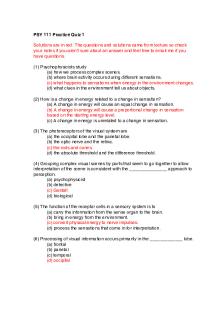Quiz perception answers PDF

| Title | Quiz perception answers |
|---|---|
| Course | Introduction To Psychology |
| Institution | Illinois State University |
| Pages | 2 |
| File Size | 49.8 KB |
| File Type | |
| Total Downloads | 93 |
| Total Views | 127 |
Summary
Download Quiz perception answers PDF
Description
PSY 111 Practice Quiz 1 Solutions are in red. The questions and solutions came from lecture so check your notes if you arenʼt sure about an answer and feel free to email me if you have questions. (1) Psychophysicists study (a) how we process complex scenes. (b) where brain activity occurs during different sensations. (c) what happens to sensations when energy in the environment changes. (d) what clues in the environment tell us about objects. (2) How is a change in energy related to a change in sensation? (a) A change in energy will cause an equal change in sensation. (b) A change in energy will cause a proportional change in sensation based on the starting energy level. (c) A change in energy is unrelated to a change in sensation. (3) The photoreceptors of the visual system are (a) the occipital lobe and the parietal lobe. (b) the optic nerve and the retina. (c) the rods and cones. (d) the absolute threshold and the difference threshold. (4) Grouping complex visual scenes by parts that seem to go together to allow interpretation of the scene is consistent with the _______________ approach to perception. (a) psychophysicist (b) detective (c) Gestalt (d) biological (5) The function of the receptor cells in a sensory system is to (a) carry the information from the sense organ to the brain. (b) bring in energy from the environment. (c) convert physical energy to nerve impulses. (d) process the sensations that come in for interpretation. (6) Processing of visual information occurs primarily in the _____________ lobe. (a) frontal (b) parietal (c) temporal (d) occipital
(7) Explain the difference between sensations and perceptions. From lecture: Sensations: pieces of the environment that come into the sense system via energy taken in by the sense system Perceptions: processes that interpret sensations
(8) Explain why the perceptual clue of retinal image size can cause size illusions in visual stimuli. According to the detective (bottom-up) approach to perception, retinal image size provides a clue to both distance of objects and size of objects. The interpretation of a large retinal image size then can mean something is either large or closer and sometimes these two interpretations get confused.
(9) List the four main parts of a sensory system. (1) sense organ (2) receptor cells (3) nerve cell (4) brain area Each of these was described in lecture with details about the visual sense system parts given as well....
Similar Free PDFs

Quiz perception answers
- 2 Pages

Ob quiz perception
- 2 Pages

Perception
- 3 Pages

Quiz Answers - quiz
- 2 Pages

Quiz Answers - Quiz
- 4 Pages

QUIZ Answers
- 109 Pages

Quiz Answers
- 13 Pages

Quiz, answers
- 3 Pages

Quiz, answers
- 1 Pages

PERCEPTION
- 10 Pages

Micro Quiz 2 - quiz answers
- 9 Pages

Quiz 3 - quiz 3 answers
- 5 Pages

Quiz 3 Summer - Answers - Quiz
- 3 Pages

AP quiz+answers - Weekly quiz
- 1 Pages

Quiz 7 - quiz with answers
- 2 Pages
Popular Institutions
- Tinajero National High School - Annex
- Politeknik Caltex Riau
- Yokohama City University
- SGT University
- University of Al-Qadisiyah
- Divine Word College of Vigan
- Techniek College Rotterdam
- Universidade de Santiago
- Universiti Teknologi MARA Cawangan Johor Kampus Pasir Gudang
- Poltekkes Kemenkes Yogyakarta
- Baguio City National High School
- Colegio san marcos
- preparatoria uno
- Centro de Bachillerato Tecnológico Industrial y de Servicios No. 107
- Dalian Maritime University
- Quang Trung Secondary School
- Colegio Tecnológico en Informática
- Corporación Regional de Educación Superior
- Grupo CEDVA
- Dar Al Uloom University
- Centro de Estudios Preuniversitarios de la Universidad Nacional de Ingeniería
- 上智大学
- Aakash International School, Nuna Majara
- San Felipe Neri Catholic School
- Kang Chiao International School - New Taipei City
- Misamis Occidental National High School
- Institución Educativa Escuela Normal Juan Ladrilleros
- Kolehiyo ng Pantukan
- Batanes State College
- Instituto Continental
- Sekolah Menengah Kejuruan Kesehatan Kaltara (Tarakan)
- Colegio de La Inmaculada Concepcion - Cebu
